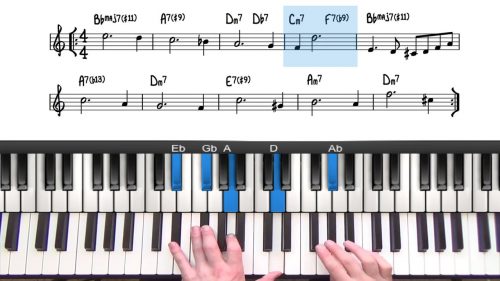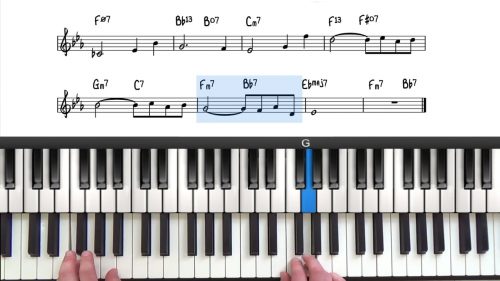Improvising Over Tenderly
In the first lesson on Tenderly, we played through the form voicing the chords with the roots, 3rds and 7ths. The second time through we then added some bigger voicings and extended chords.
In this lesson we will apply upper structure triads to the tune Tenderly and also discuss ways to add fills and runs in between the chords of this delightful ballad.
The melody utilises many extended and altered tones which makes upper structure triads particularly useful. There are also some alternate changes on the lead sheet which can be used as substitute harmony in the B section.
The final section of this lesson breaks down a number of fills and runs which can be used in between the chords when the melody is stationary. We also explore some basic concepts to develop an improvised solo over the form.
Practice Tips
-
Always have a point in mind where you resolve a scale line.
-
Transcribe your own material - this is the best way to learn new improv vocabulary.
-
Record yourself soloing. If you make a mistake just carry on. Try to play through the form at least 3 times and use the iReal Pro backing track if you like.
-
When you listen back, you will hear things that you like, things that you don't like. Make note of these and it will give you more direction to improve your improvisation.
- Ultimately, you need to make the call on whether your improvisation sounds the way you want it to... who else is going to tell you that? Remember we play for ourselves first and others second.







Beautiful sounds, interesting ideas, lots of food for the brain, thanks!
can you provide a simple lead sheet for this that we can print?
Hayden, can you give us your lead sheet, so we can take notes and write on it?
Hi Lori, yes sure here is the lead sheet I’m working from: pianogroove.com/wp-content/uploads/2016/07/Tenderly.pdf
Anything else I can help with just let me know :-)
Thanks, PianoGroove
Thanks ! Tons of great tips packed in just one beautiful lesson with the added benefit of being able to play in the end such a beatiful arrangement !
Nico
Thanks Nico… glad you enjoyed the lesson.
And yes, “Tenderly” is a beautiful tune to play over :-)
Cheers,
Hayden
Hi Hayden, I learnt Tenderly a while back from Pianogroove I just saw there is an improvisation video too.
I will study it.
Here’s how far I got so far.
Could you look on my page please and tell me which other video lessons have a second part please?
Hi Simon,
Sorry for the late reply here, this comment slipped past me.
You can use the search box in the header of the website to find related lessons.
If you search for the jazz standard name the search feature will return all other lesson pages on the site where it is mentioned.
Throughout the courses we reintroduce earlier jazz standards as examples and to demonstrate certain concepts.
Let me know if I can be of further assistance.
Cheers,
Hayden
Thanks Hayden, that’s fine.
Hi Hayden,
In bar Nr. 8 you are playing an upper structure over #5, but the melody note is b7 (Bb). Shouldn‘t it be an U.S. #4, because the melody note must be in the U.S. triad? So I have learned in the Cheat Sheet from the practise guide for Upper Structure triads.
Best regards, Jochen
Hi Jochen 👋
Yes you are correct that the we could play the US#4 in this case. The reason I chose to play the US#5 is because we have a rest in the melody in bar 8 which gives us some freedom to play any chord colours/UST that we like.
The Bb in the melody in bar 8 is a very quick passing note (the final 8th note in the measure) which leads chromatically into the B natural in bar 9, and I chose to play this as a single note and add an upper structure triad before it. This is personal taste.
You can certainly harmonise that final note Bb with the US#4, for me it sounds quite heavy and I prefer to just play that note as a single note, but there is no set-in-stone rule here.
You could even play both USTs in the same bar… start with US#5 as I demonstrate, and then quickly play US#4 to harmonise the Bb in the melody before moving to F-7b5 in bar 9.
The interesting thing when combining US#4 and US#5 is that we then play all of the alterations in the 2 voicings (b9, #9, #11, & #5). US#5 gives us #9 and #5, and US#4 gives us b9 and #11, and so in a single bar we have used 2 voicings to play every alteration possible over the dominant chord!
Again this many alterations in a short space may or may not be to your taste, and so always follow your ears on what sounds best to you.
I hope that helps and let me know if you have any questions.
Talk soon,
Hayden
ps. Keep using the UST cheat sheet as a reference and soon these formulas and voicing shapes will become natural and instinctive so that you don’t need to think too much about them. You will see the chord symbols and your hands will gravitate to towards the shapes.
Hi Hayden, good lesson as I’m working on this tune right now. I’m struggling to get my head around the upper structure chords. I hear you adroitly creating these chords and have a basic understanding I have difficulty applying them.
I need to go back to that lesson. I know its chords created off extended notes like 9ths etc. I’m a little overwhelmed, okay a lot, on where to focus my practice/learning.
I learned from another teacher how to go thru a lead sheet and write spread voicings that sound good and minimize hand movements for the chords so I’m not playing all closed voicings.
Trying to mix in playing some arpegiated chords in stride style like you recommended in a lesson..
I guess I’m still weak in the theory of relating to notes as numbers, I am using the simplified piano practice planner.
Thanks for all your passion and inspiration.
Cheers from Los Angeles
Eric Howland
Hello Hayden: when I try to download the Tenderly Transcription I get a 404 message: File not found
Hi Guillermo,
Thanks for letting me know – I have fixed the download link.
It seems that URL is case sensitive, and the previous PDF URL was lowercase which resulted in the file not being found.
I have fixed this so if you click above in the downloads section, the PDF is now accessible.
Talk soon,
Hayden